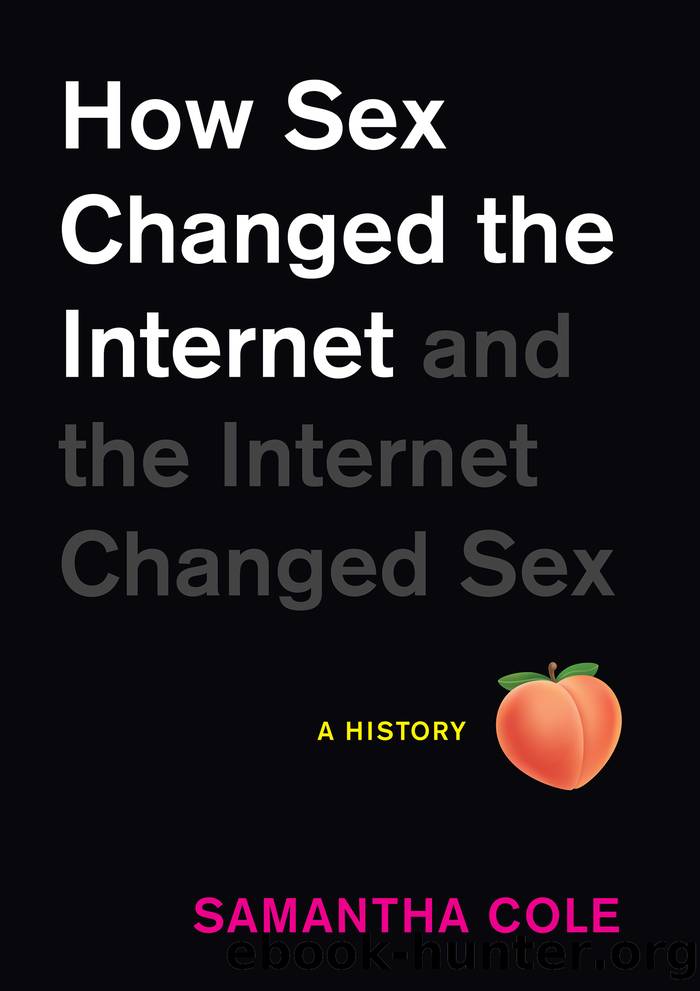How Sex Changed the Internet and the Internet Changed Sex by Samantha Cole

Author:Samantha Cole
Language: eng
Format: epub
Publisher: Workman Publishing Company
Published: 2022-11-15T00:00:00+00:00
Chapter 9
Plug and Play
Internet-Connected Sex Toys
âJust twist the base and away she goes. Gives fast, penetrating comfort. Makes strained, sore muscles feel new. Stimulates circulation, too. Five minutes does the job. Give it to her.â
âSixties massager advertisement
While the boys at Stanford were getting ARPANET up and running in the seventies, a young Dell Williams was trying to buy a vibrator at a Macyâs in New York City.
Sheâd attended one of Betty Dodsonâs sex education workshops, where the preeminent feminist voice for masturbation-as- radicalization recommended the Hitachi Magic Wand. This was before Hitachi became a household name in mind-blowing orgasms; the device was still being marketed as a muscle massager. But its reputation for off-label uses was getting around, and Williams wanted to find out for herself.
âWhat do you want it for?â the greasy guy running the register in front of her asked. Loudly.
âI left Macyâs that day,â Williams wrote in her memoir, âclutching my precious, anonymous brown shopping bag and thinking: Someone really ought to open up a store where a woman can buy one of these things without some kid asking her what sheâs going to do with it.â Williams opened exactly that store, Eveâs Gardenâlocated around the corner from Carnegie Hallâin 1974. It was the first feminist sex toy shop.
Three years later, in San Franciscoâs Mission District, sex therapist Joani Blank opened Good Vibrations, the cityâs soon-to-be-storied sex toy shop. The shop was more than a place to buy dildos. It became the locus of the sex-positive movement in the West Coast, at a time when Deep Throat was hitting the mainstream.
The sexual revolution of a generation started in sex toy stores, by women seizing the means of orgasm.
Since then, the sex toy industry has exploded. The global market is worth more than $26.6 billion, and analysts expect it to reach $52.7 billion by 2026. A large part of that growth, they predict, will be in toys that are connected to, and controlled by, an app on your phone. Now, everything we do can be augmented by mobile appsâpaying bills, ordering food, dating, and, of course, sex.
âMany [investors] are wary of missing out on what may be one of the last great untapped retail markets in the world,â wrote Andrea Barrica, CEO and cofounder of pleasure education platform O.school, in her book Sextech Revolution. âBut theyâre also nervous. Investors are largely older men, which means they sometimes donât understand the problems to be solved. Or they answer to more conservative institutions that wonât invest in âvice.â Stigma keeps them from sextech.â
Stigma has kept marginalized people locked out of their sexual power for eons. Barrica grew up in a strict Filipino-Catholic household, immersed in a purity culture that told her there was only one model for acceptable sex: straight, Christian, and virginal until marriage. Anything else was sinful, or would end in rampant STDs, like the medical photos her school health teacher showed in class. Her first experience of someone else affirming her sexual needs was from a
Download
This site does not store any files on its server. We only index and link to content provided by other sites. Please contact the content providers to delete copyright contents if any and email us, we'll remove relevant links or contents immediately.
Cecilia; Or, Memoirs of an Heiress — Volume 1 by Fanny Burney(32503)
Cecilia; Or, Memoirs of an Heiress — Volume 2 by Fanny Burney(31913)
Cecilia; Or, Memoirs of an Heiress — Volume 3 by Fanny Burney(31898)
The Great Music City by Andrea Baker(31759)
We're Going to Need More Wine by Gabrielle Union(19004)
All the Missing Girls by Megan Miranda(15782)
Pimp by Iceberg Slim(14438)
Bombshells: Glamour Girls of a Lifetime by Sullivan Steve(14024)
For the Love of Europe by Rick Steves(13625)
Talking to Strangers by Malcolm Gladwell(13297)
Norse Mythology by Gaiman Neil(13281)
Fifty Shades Freed by E L James(13188)
Mindhunter: Inside the FBI's Elite Serial Crime Unit by John E. Douglas & Mark Olshaker(9265)
Crazy Rich Asians by Kevin Kwan(9224)
The Lost Art of Listening by Michael P. Nichols(7456)
Enlightenment Now: The Case for Reason, Science, Humanism, and Progress by Steven Pinker(7274)
The Four Agreements by Don Miguel Ruiz(6704)
Bad Blood by John Carreyrou(6584)
Weapons of Math Destruction by Cathy O'Neil(6220)
